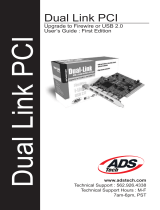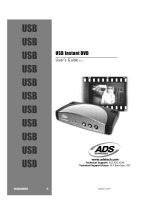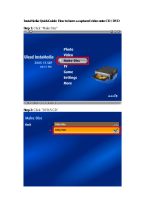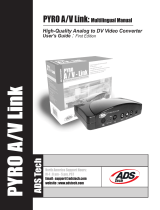Page is loading ...

User Guide
Ulead Systems, Inc.
November 2001

First English edition for Ulead VideoStudio version 6.0, November 2001.
© 1992-2002 Ulead Systems, Inc.
All rights reserved. No part of this publication may be reproduced or transmitted in any form or by any
means, electronic or mechanical, including photocopying, recording or storing in a retrieval system, or
translated into any language in any form without the express written permission of Ulead Systems,
Inc.
Software license
The software described in this document is furnished under a License Agreement, which is included
with the product. This Agreement specifies the permitted and prohibited uses of the product.
Licenses and trademarks
ICI Library © 1991–1992 C-Cube Microsystems.
Ulead Systems, Inc., Ulead, the Ulead logo, and Ulead VideoStudio are trademarks of Ulead Systems,
Inc. All other product names and any registered and unregistered trademarks mentioned in this
manual are used for identification purposes only and remain the exclusive property of their respective
owners.
Sample files
Files provided as samples on the program CD can be used for personal demonstrations, productions
and presentations. No rights are granted for commercial reproduction or redistribution of any sample
files.
North & South America: International:
Ulead Systems Inc. Ulead Systems, Inc.
http://www.ulead.com http://www.ulead.com
E-mail: [email protected] http://www.asiapac.ulead.com
http://www.ulead.com.tw
E-mail: [email protected]
Europe: Japan:
Ulead Systems GmbH Ulead Systems, Inc.
http://www.ulead.de http://www.ulead.co.jp

Table of Contents
The big picture ................................................................................ 6
An introduction to digital video .......................................................................................6
Key features of DV.........................................................................................................7
Analog to digital .............................................................................................................7
An introduction to MPEG ...............................................................................................8
MPEG-1 ...............................................................................................................................8
MPEG-2 ...............................................................................................................................8
How VideoStudio works .................................................................................................9
Whats new? ................................................................................. 10
System requirements ....................................................................... 12
Hardware checkup before using VideoStudio ........................................... 13
DV IEEE 1394 capture card.........................................................................................13
Analog capture card.....................................................................................................15
USB port ......................................................................................................................15
Installing and running VideoStudio ....................................................... 16
Configuring VideoStudio .................................................................... 17
DV (IEEE 1394 capture card) ......................................................................................17
Analog capture card.....................................................................................................18
USB input device .........................................................................................................18
Getting around VideoStudio ............................................................... 19
The Library...................................................................................................................23
Library Manager ................................................................................................................24
Steps to create your movie ................................................................. 25
Start.............................................................................................................................27
Creating a new project .....................................................................................................27
Selecting a template.........................................................................................................29

Capture ........................................................................................................................31
Checklist for successful video capture............................................................................31
Capturing DV video ...........................................................................................................32
Capturing analog video ....................................................................................................32
Direct capturing MPEG video............................................................................................33
Scene Detection / Split by Scene .....................................................................................34
Capturing still images ......................................................................................................35
Captured video file size in Windows................................................................................35
Batch Capture ...................................................................................................................36
Storyboard ...................................................................................................................38
Storyboard Mode ...............................................................................................................38
Timeline Mode ..................................................................................................................39
The Options Panel............................................................................................................40
SmartRender and Play Project button .............................................................................41
Preview Files Manager .....................................................................................................42
Inserting a clip into the Timeline......................................................................................42
Trimming a clip .................................................................................................................43
Working with clips.............................................................................................................44
Capturing still images in the Storyboard Step.................................................................46
Using color clips...............................................................................................................46
Using video filters .............................................................................................................47
Effect ...........................................................................................................................49
Creating effects .................................................................................................................49
Customizing effects ..........................................................................................................50
Overlay.........................................................................................................................51
Inserting video/image in the Overlay track.......................................................................51
Customizing overlays .......................................................................................................52
Title..............................................................................................................................53
Creating text titles .............................................................................................................54
Rolling & scrolling ............................................................................................................56
Fading in & out ..................................................................................................................57
Putting it all together .........................................................................................................57
Audio ...........................................................................................................................58
Creating voiceover narration ............................................................................................60
Creating background music.............................................................................................61
Customizing background music......................................................................................62
Mixing it together ...............................................................................................................62
Fade...................................................................................................................................63

Finish...........................................................................................................................64
Creating and saving a video file.......................................................................................64
Video Save Options ..........................................................................................................66
Creating a DVD / VCD / SVCD Title ..................................................................................71
Project Playback................................................................................................................71
Creating an audio file .......................................................................................................71
Exporting your movie ........................................................................ 72
Burning DVD/VCD/SVCD.............................................................................................72
Compressing video
for the Web ........................................................................................................................74
Putting a movie on the Web.........................................................................................74
Posting your video on a Web page ..................................................................................75
Sending a movie by E-mail ..........................................................................................76
Electronic greeting cards .............................................................................................77
Recording back to a DV camcorder .............................................................................78
Shortcuts ..................................................................................... 79
Need more help? ............................................................................ 80
Glossary ....................................................................................... 81
Index ........................................................................................... 83

6 VIDEOSTUDIO USER GUIDE
The big picture
Digital video editing used to be dominated only by professionals. Advances in technology,
however, made it possible for almost anyone to create desktop video productions even at
home. As personal computers become increasingly powerful, video editing software also
become smarter.
Ulead VideoStudio puts you at the cutting edge of video technology by providing a complete
set of tools to cut, mix, run titles, add special effects, and do almost anything digitally possible
with your work. Even novices achieve professional results as VideoStudio turns the complex
process of video editing into a simple and fun affair.
An introduction to
digital video
Tens of millions of camcorders and personal
computers have been sold around the world
and video capture cards serve as the connec-
tion between the two. These cards allow the
transfer of video data from the camcorder to
the computer hard disk.
The introduction of the IEEE 1394 interface
technology also known as FireWire or i.Link
and the emergence of a generation of entirely
digital camcorders and a new format to
emerged - digital video (DV).
VideoStudio fully supports digital video (DV)
editing and puts all the advantages of working
with this format in your hands.
DV camcorders are
compact and simple
to operate
VideoStudio lets you output
your video projects in a wide
range of storage media

THE BIG PICTURE 7
Key features of DV
Digital video boasts of excellent lossless
quality since its data is processed in purely
digital form. Its viewing area is large at
720x480 pixels, with more than 500 lines of
horizontal resolution and PCM 16 / 12 -bit
stereo sound. This means sharper images,
more vibrant colors, and crisp CD quality
audio.
Digital video data can be controlled and
manipulated more accurately than analog
signals. This makes it easier for you to apply
modifications, transitions, and special effects
to specific segments or even to a single
frame.
And of course, portability is a major advan-
tage of digital video as DV camcorders and
tapes are more compact and lightweight to
carry around compared to their analog
counterparts.
Analog to digital
VideoStudio also supports analog video to
allow you to convert video from old High-8,
8 mm, VHS, and S-VHS tapes to digital
compact discs.
Use an analog capture card to digitize footage
from analog devices. Once digitized, you can
edit these footage in your computer and
output them in a format of your choice.
Apply digital effects in VideoStudio
with one click of a button

8 VIDEOSTUDIO USER GUIDE
An introduction to MPEG
The Moving Picture Experts Group (MPEG)
defined a series of standards for compressing
or reducing the file size of video to make it
easier for computers to handle.
VideoStudio allows you to work with both
MPEG-1 and MPEG-2 formats to create VCD
and DVD movies with amazing frame-
accurate technology.
MPEG-1
Also known as the White Book standard,
MPEG-1 gives you VHS quality video which
you can burn to a CD and play back using a
regular CD player. Popularly known as the
VCD format, MPEG-1 enables more than 70
minutes of good quality video and audio to be
stored on a single CD-ROM disc.
MPEG-2
A standard for coding video at higher data
rates and in an interlaced format, MPEG-2
allows multi-channel sound recording and
enables a resolution four times greater than
MPEG-1. It is optimized for higher-end
applications such as satellite broadcast and
DVD.
Note: MPEG-4, a more recent development, allows video
and sound recorded by cameras and microphones to
work smoothly with their computer-generated
counterparts.

THE BIG PICTURE 9
How VideoStudio works
VideoStudio follows a step-by-step paradigm
so that editing tasks remain uncomplicated
from start to finish. VideoStudio also offers
more than a hundred transition effects,
professional titling capabilities and simple
soundtrack creation tools. Learn in seconds,
create in minutes.
VideoStudio breaks up your movie into
separate tracks, giving you broad creative
freedom. Changes to one track do not affect
others.
After transferring footage from your
camcorder, you can arrange scenes, apply
special effects, overlay images, add animated
titles, sync in a voiceover narration, and use
background music from your favorite CDs in
formats such as WAV and MP3. All these can
be done using drag-and-drop, cut-and-paste,
or select-and-apply operations.
All the tracks in your movie are then orga-
nized into a video project file (*.VSP), which
contains all the video and audio information
on how your movie is put together.
When everything is all set to go, your
computer collects all information needed to
create your final movie file. This process is
called rendering.
You can then output and distribute your
movie as a DVD/VCD/SVCD title, streaming
Web page video, or an e-mail attachment.
You can also record your movie back to your
camcorder or VCR.
Components of a finished project as displayed in
Timeline Mode
The VideoStudio workspace
Footage can be captured
from your camcorder and
digitized for editing in
your PC

10 VIDEOSTUDIO USER GUIDE
Whats new?
Take advantage of VideoStudio’s latest features and enhancements:
• Advanced interface design - Enjoy working
with a responsive task-based interface. The
Preview Window can even be enlarged to let
you analyze color, texture, or motion in
greater detail while making full use of display
space even at a resolution of 1024 x 768 or
higher.
• MPEG capture from IEEE 1394 - Capture
MPEG directly from your DV camcorder
with the IEEE 1394 interface. Save a lot of
hard disk space and skip the task of having to
convert files to MPEG. A must for those
who plan to output movies in VCD or DVD!
• Scene detection while capturing to
multiple files - Manage your files better!
During capture, break your video into several
files automatically based on changes in
recording date and time. This applies to DV
format video.
• SMPTE time code editing - For editing jobs
that require precise timing, such as animation,
the SMPTE (Society for Motion Picture and
Television Engineers) time code lets you
work faster and more efficiently. By having a
number assigned to each frame representing
hours, minutes, and seconds, you get frame-
accurate control of your editing task.
• Ulead COOL 3D animations - Generate
animated graphics with amazing special
effects in Ulead COOL 3D and simply insert
it in the Video or Overlay Track. Ulead’s
hottest 3D titling package, Ulead COOL 3D
even allows you specify frame rate or size
and codecs.

WHAT’S NEW? 11
• Enhanced title motions - A wide range of
motion style presets in the Animation
Library folder allows you to produce an
impressive choreography of eye-catching
titles to match the look and feel of your
video.
• Video and image overlays - Put together
dynamic compositions of overlapping videos
and images. Transparency controls remove
the usual bounding box so you can create
animated logos, cartoon clips over live
footage, and a lot of other interesting effects.
• QuickTime streaming - Stream your video
over the Web in QuickTime for full-frame
(640 x 480), full-motion (30 fps) quality.
QuickTime is a cross-platform standard that
supports many file formats and codecs.
• Instant preview - Preview your video
without having to create a temporary file.
Select Instant preview to save hard disk
space and rendering time.
• Multiple CD-ROM support - Hook up
several CD-ROM drives to your PC and
music tracks can be acquired from any
selected drive.

12 VIDEOSTUDIO USER GUIDE
Tip: Follow the installation instructions of your hardware
components carefully, particularly your capture card
and consult the operating manual of your camcorder
or capture device.
System requirements
Video demands a lot from your computer. When setting up your system for video editing,
the basic factors to consider are the size and speed of your hard drive, RAM, and processor.
These determine how much video you can store and how quickly you can process or render
your files. If you can afford a bigger hard drive, higher RAM, and faster chip, go with it.
Just remember that technology is changing so rapidly and by evaluating first the kind of
video editing projects you plan to do, you can better determine the setup that works best for
you.
Following are the system requirements for setting up VideoStudio:
• Microsoft Windows 98, Windows 98 SE,
Windows Me, Windows 2000, Windows XP
• 450 MHz above CPU speed is recommended
• 64 MB of RAM (128 MB or above for
editing)
• 500 MB of available hard disk space or
above; 4 GB is recommended (best results can
be achieved with a 30 GB Ultra-DMA/66
72000 rpm. hard disk)
• Video for Windows and DirectShow compat-
ible video capture card
• Windows compatible sound card
• CD-ROM or DVD-ROM drive

HARDWARE CHECKUP BEFORE USING VIDEOSTUDIO 13
Hardware checkup before using
VideoStudio
To ensure that your video production runs smoothly and trouble-free, click Control Panel:
Systems - Device Manager and check if your devices are working properly in accordance
with your Operating System (O/S).
DV IEEE 1394 capture card
The following Windows operating systems support the IEEE 1394 capture card. Always
remember to turn on your DV camcorder or VCR connected to the IEEE 1394 interface so
that it can be detected as image device or sound, video and game controller.
A device list on the Device Manager in the Systems
Properties dialog box, Windows Me.
Windows 98
Windows 98 supports the Texas Instruments
DV driver only but does not provide it.
Search the drivers (if bundled) that come
with the IEEE 1394 card. Check that the
following devices are working properly:
• 1394 Bus Controller
• Sound, video and game controllers: 1394
camcorder
Windows 98 Second Edition /
Windows 2000
Windows 98 Second Edition and Windows
2000 include the Microsoft DV driver and still
support the Texas Instruments DV driver.
Check that the following devices are working
properly:
• 1394 Bus Controller
• Image Device: Microsoft DV Camera and
VCR (For Microsoft DV driver only.)
• Sound, video and game controllers: 1394
camcorder (For Texas Instruments DV driver
only.)

14 VIDEOSTUDIO USER GUIDE
Settings Tab after clicking Properties
when a hard drive is selected from
Control Panel: System - Device Manager
Windows Millennium Edition (Me)
Windows Me fully supports the IEEE 1394
card. Check that the following devices are
working properly:
• 1394 Bus Controller
• 61883 Device Class
• AVC Device Class
• (Brand name) DV Camcorder: The brand
name depends on the DV camcorder con-
nected to the IEEE interface card.
Windows XP
Windows XP fully supports IEEE 1394 and is
also the only PC O/S that offers wireless
access to cameras and other devices over a
network. On a wireless IEEE 802.11 home
network, attach an IEEE 1394-enabled laptop
to a Windows XP-based PC and instantly
access all other connected devices.
To run VideoStudio under Windows XP,
check that the following devices are working
properly:
• 1394 Bus Controller
• 61883 Device Class
• AVC Device Class
• (Brand name) DV Camcorder: The brand
name depends on the DV camcorder con-
nected to the IEEE interface card.
For Windows 98 and Windows Me, select the DMA option in Device Manager: Disk drive
Settings Tab. In Windows 2000, the DMA option is hidden but it is always enabled. DMA
avoids possible drop frame problems later when you are capturing video.
Note: In addition to commonly used Texas Instruments and Microsoft DV drivers, there are other drivers available.
Consult your camcorder’s manual for suitable drivers.

HARDWARE CHECKUP BEFORE USING VIDEOSTUDIO 15
Analog capture card
Windows 98, 2000, Me, and XP supports analog capture cards. Remember to turn on the
camcorder or VCR and connect it to your computer. Then check that the following devices
are working properly:
• Sound, video and game controllers
USB port
The Universal Serial Bus (USB) connector lets you attach a wide array of devices to your
computer quickly and easily. These devices include digital cameras, Webcams, and just about
every computer peripheral. Since Windows 98, 2000, Me, and XP fully support USB, installing
the driver for this device is quick and easy too. Check that the following device is working
properly:
• Universal serial bus controller

16 VIDEOSTUDIO USER GUIDE
To install VideoStudio:
1. Place the VideoStudio CD into your CD-ROM
drive.
2. When the Setup screen appears, follow the
instructions to install VideoStudio onto
your computer.
Note: If the Setup screen does not appear after loading the
CD, then you can manually start it by double-
clicking the My Computer icon on your desktop,
then double-clicking the icon for the CD-ROM
drive. When the CD-ROM window opens, double-
click the Setup icon.
Note: Skip this step if you already have newer versions of
the above supporting applications installed in your
PC.
To run VideoStudio:
• Double-click the VideoStudio icon on your
Windows desktop.
OR
• Select the VideoStudio icon from the
VideoStudio program group on the Windows
Start menu.
Installing and running VideoStudio
VideoStudio installation screen
Please install also the following applications, because they are very important in making digital
video work well on your computer. The installation program will walk you through installing:
• QuickTime
• Windows Media Format
• RealPlayer
• Acrobat Reader
Running VideoStudio from Windows Start menu

CONFIGURING VIDEOSTUDIO 17
To check the setup of VideoStudio for DV
interface:
1. Connect your camcorder to your IEEE
1394 capture card.
2. Insert your video tape into the camcorder
and switch it on. Make sure it is in playback
mode (usually named VTR or VCR). Check
your camcorder’s manual for specific
instructions.
3. Your Capture plug-in and Device control will
be detected automatically based on your
selected template.
4. Click Capture Step and check if your device
is displayed in the Options Panel under
Driver.
Note: When your camcorder is in Record mode (usually
named CAMERA or MOVIE), you can still capture
real-time video directly in VideoStudio, even if
there’s no video tape inserted.
Configuring VideoStudio
Camcorders, VCRs, and VCD/DVD players are common sources of video footage. To ensure
a smooth interaction between these video sources and your computer, make sure that the
settings of VideoStudio are configured properly depending on the capture device you are using.
DV (IEEE 1394 capture card)
Check that your device is listed under Driver

18 VIDEOSTUDIO USER GUIDE
Analog capture card
To check the setup of VideoStudio for analog
interface:
1. Connect your camcorder, VCR, or other video
source device to your analog capture card.
2. Insert your videotape into the capture device
and switch it on. Make sure it is in the
playback mode (usually named VTR or
VCR). See your machine’s manual for
specific instructions.
3. Your Capture plug-in will be detected
automatically.
4. Click Capture Step and check if your device
is displayed in the Options Panel under
Driver.
Note: If your capture device supports multiple video
sources, the Input Source dialog box allows you to
select your desired video source such as Composite,
Tuner, or S-Video. Likewise, if you have multiple
audio sources, this dialog box allows you to select
your desired audio source.
USB input device
To check the setup of VideoStudio for USB
interface:
1. Connect your video source device to your
USB port using a standard USB cable and
switch it on.
2. Your Capture plug-in will automatically be
detected.
3. Click Capture Step and check if your device
is displayed in the Options Panel under
Driver.

GETTING AROUND VIDEOSTUDIO 19
Getting around VideoStudio
The VideoStudio interface has been designed to make the sometimes complicated task of
editing movies on your PC intuitive and enjoyable. The illustration on this page shows an
overview of the entire program, while the next few pages detail more specific features.
Track buttons
Each activates a track to edit.
Click a button to change the
Preview Window and available
options accordingly.
Trim Bar
Used for trimming,
editing, and cropping
video clips.
Timeline
Represents the period
of time that a clip
appears in your movie.
Library
Stores and organizes all
of your media clips.
Load media button
Click to add video or
audio files to the
Library.
Folder button
Click to switch between
various library folders.
Preview Window
Shows the current clip,
video filter, effect, or
title.
Options Panel
Contains controls,
buttons, and other
information.
The Options Panel
The Options Panel changes depending on the
program’s mode and the step or track you are
working on. The Options Panel may contain
one or two tabs. Information in each tab vary
depending on the selected clip.
Options Panel in
Storyboard Step

20 VIDEOSTUDIO USER GUIDE
ToolTips
Place the mouse over a button or object to display a
balloon which identifies the item.
Zoom controls
Increase or decrease the
number of frames
displayed in the
Timeline.
Selected range
These color bars represent the
trimmed or selected part of a clip
or project.
Trim handle
Click and drag to trim
a clip.
Time units
Represents the timing
of clips in hours :
minutes, seconds, and
milliseconds
Project scroll
controls
Use the left and right
buttons or grab the
Scroll Bar to move
around your project.
Insert media files
Displays a menu allowing you
to place video, audio or image
clips directly on the project.
Storyboard and Timeline
Click tabs to switch between
Storyboard Mode and
Timeline Mode.
Preview Bar
Click and drag these
controls to scroll
through a clip. The
position is shown in
the Preview Window’s
content.
/




